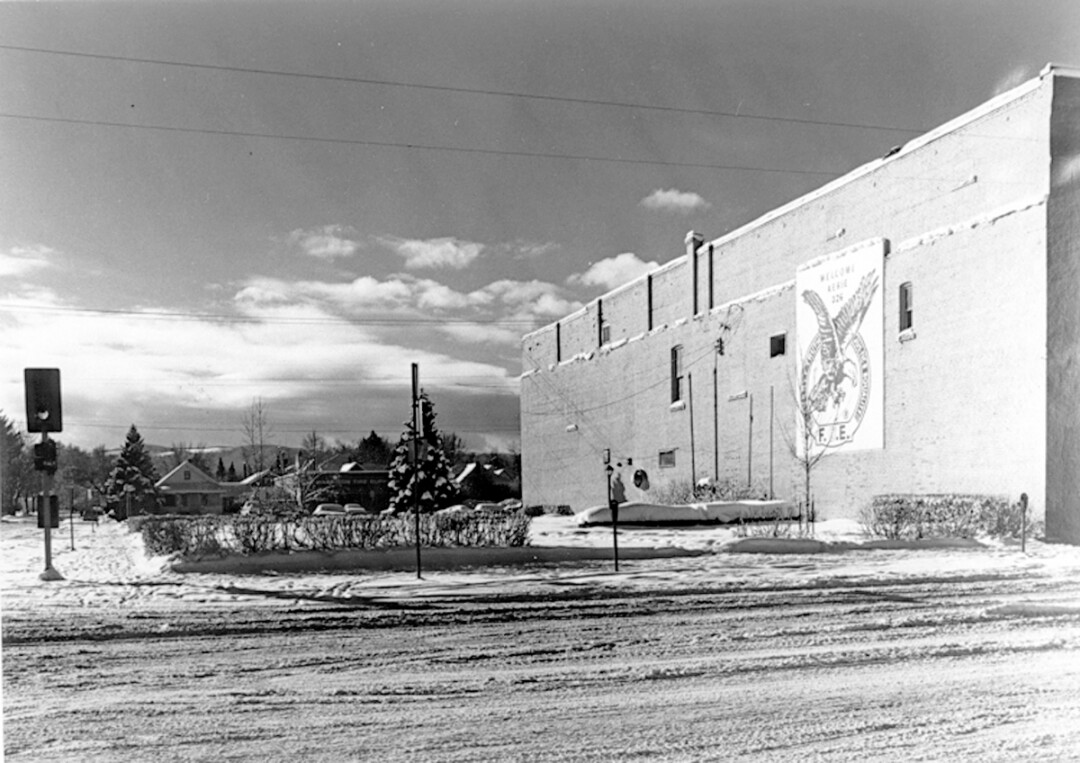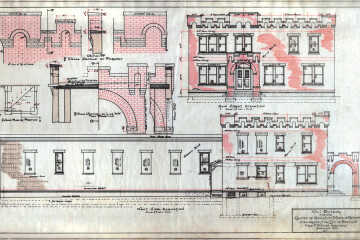The Story of the Bozeman City Hall / Opera House in Three Acts
If you can find a quiet time to sit in the little park on the southwest corner of Main and Rouse in Downtown Bozeman, and if you listen close enough, you might hear soft echoes from the past--jail cells clanging closed, fire bells ringing and quite possibly the sounds of the Queen City Band from the opening night of The Bozeman Opera House on September 19, 1890.
For more than seventy-five years a massive, ornate brick, stone, and cast iron building was the headquarters for the city administration for Bozeman. The big fire engines were housed in one section of the lower floor with firemen’s quarters above and the traditional brass pole at the side. In the other half of the building were offices for city administrators with a long hall leading back to the jail cells and janitor’s quarters. The second floor housed the police headquarters and a large courtroom and from there a small door opened to the grandeur of a 900 seat auditorium, The Bozeman Opera House.
An interesting concept of combined use for city business and community civic space, one could imagine a desire to present a united community to travelers and citizens alike as the planning for this structure actually predates Montana’s statehood.

Act 1-One Man’s Dream Becomes a Community Treasure
Planning for the city hall began in 1887. In April of 1887, John Bogert was elected mayor and at the same time a $10,000 bond was approved to finance a new city hall.
Architect Byron Veerland spent three weeks planning the structure and, once completed, the plans for the new city hall had grown to include an opera house to occupy the majority of the second floor. Veerland explained that while the structure would look like a three-story building from the outside, the inside height of the second floor would accommodate the opera house auditorium and balcony.
Despite continuing troubles with bids and more bond issues, the cornerstone was dedicated on July 4, 1888. Mayor Bogert loved a grand celebration and the Fourth of July was the perfect timing for his pet project’s public dedication. With the Territorial Governor Preston H. Lesley in attendance, the procession was headed up by a marching band in glimmering new uniforms; from the end of Main Street they marched to Broadway and then retraced their march to the city hall/opera house site. The Avant Courier reported that following Governor Lesley and Mayor Bogert, the procession included the City Council, distinguished citizens, dismounted militia and three fire companies with the hose company handsomely arrayed in velvet-trimmed jackets. Last but not least Mr. Slusser and Mr. Henke, who manufactured cigars, threw cigars into the crowd.
With the large crowd now assembled at the corner of Rouse and Main, W. W. Alderson (publisher of the local newspaper the Avant Courier) delivered a speech reviewing the notable events in the development of the town followed by Mayor Bogert describing the history of the city hall, saying in part, “This building is the election of our people—by a vote of more than 11 to 1, the ordinance permitting it was adopted at the polls—and though trouble and delay have followed, yet its foundation is completed, and as we lay this cornerstone I know I may declare that, no matter what the opposition, the will of the people must prevail and this build shall at last become our City Hall.”
With that said he placed a metal box to serve as a time capsule and stated “I now declared this cornerstone laid; in the name of the people of Bozeman, dedicate this structure to the uses of the city forever.”
The project was fraught with more financial trouble but the citizens wanted their city hall/opera house and voted in favor of additional bond levies. In September 1890 the fire department moved in, hanging the fire alarm bell in the bell tower and the fire engine moved into its quarters with the horses stabled nearby. City officials furnished their rooms and rented out others. The city police department found a home here and provided a few cells to house “guests” and the hum of city business remained constant for the next three quarters of a century.

Act 2-The Bozeman Opera House Becomes the Focal Point of Bozeman’s Cultural Life
Three years and 10 days after the original plans were accepted, the Bozeman Opera House opened with a grand concert by the Queen City Band, a group of local musicians. The proceeds from this concert provided scenery and curtains for the stage.
The first performance by an out-of-town group took place on October 13, 1890, featuring the Mendelssohn Quintet Club of Boston sponsored by the Volunteer Fire Department. The Avant Courier described it as a rare treat for lovers of good music and said of the opera house, “It is without a doubt as handsome as any in the state. The curtain is a beautiful piece of art, representing a Venetian scene, and the scenery and stage furniture are very handsome.”
Drama, music, and political rallies were not the only features in the early days of the hall. The seats were removable, and on January 16, 1891, a promenade concert by the opera house orchestra was followed by dancing on the parquet.
In March of 1891 the new Bozeman Hotel, located across the street from the city hall/opera house had its grand opening. The hotel received free use of the auditorium for the occasion, plus permission to build a footbridge from the second floor of the hotel across Main Street to the opera house. Orchestras furnished music for dancing there and in the hotel, with guests moving freely between the two builds over the bridge. Unfortunately the bridge was removed immediately afterwards but the calendar of events for the Bozeman Opera House continued to grow.
During the next couple of years Bozeman became known as a “show town”, located on the Northern Pacific Railway between Minneapolis and Seattle with large nationally renowned acts stopping to perform for the citizens of the valley. The panic of 1893 hit Bozeman hard as banks closed and unemployment mounted. The number of road shows dropped sharply, and for a time the opera house was often dark. But the next year the lack of professional shows was counteracted by local people who put on a series of concerts, minstrel shows and plays yet again providing cultural and social activities for a town that had grown accustomed to the finer things most towns of similar size at this time were lacking.
On March 19, 1898 the Bozeman Opera House, just eight years old, was ridiculed on her own stage when traveling acclaimed actor Frederick Warde gave a curtain speech incensed that the dressing room ceilings were only 5 ½ feet high, and annoyed because the stage roof was not raised enough to permit the use of modern scenery.
Mr. Warde’s speech spurred the city administration to refer the matter to the Committee on Public Buildings and eventually it recommended that “a new roof be placed on the city hall building and that the building be painted and several of its rooms calcimined. That the foundation of the building be repaired, that the roof be raised over the stage, that the floors of the dressing room be lowered and that a room be built in which to store scenery.”
This decision forever changed the outside appearance of the majestic building as Helena Architect C. S. Haire prepared plans to put on a flat roof by building up the outside walls fifteen feet higher. To give the illusion of a third story, windows lighting an unreachable pseudo-attic were installed in the raised wall. The contract was awarded in the amount of $5633.00 and construction began in September 1898.
Traveling shows continued to stop in Bozeman and the auditorium served as a civic center as well as theater, and each election year provoked an eruption of political bookings. In 1899 the opera house purchased a moving picture machine, and on July 3 showed the Sharkey-McCoy fight, plus scenes from the Spanish-American War. In 1903 the building was rewired and in 1905 the population of town had reached 5000 and saw a peak of shows including vaudeville shows, minstrel shows and finally a cat and dog circus which presented Funny Folks.
But competition from the movie houses called electric theatres brought changes. The Gem theater opened in 1908, and to compete, movies were being shown in the opera house in the intervals between live shows. With fewer road shows and improvements needed the city took over direct control of the opera house in 1914. City clerk, Carl A. Spieth, oversaw the auditorium’s remodel that included removal of the boxes and the lower proscenium arch was built. The county high school received the old curtains and the property room was ordered cleared of rubbish. In 1916 the opera house became the Municipal Theater and World War I took the traveling companies off the road.

Act 3-The End of an Era and the Needs of City Government
Rundown and often empty, the old opera house now drew crowds only on rare occasions. Boxing and wrestling were featured for a short period, with a ring constructed on the parquet and bleacher seats built on the stage.
Where once musicians, actors, dancers and performers of all genres delighted Bozeman’s culture thirsty citizens now was all but deserted. Through the 1920’s the National Guard rented the space and soldiers marched and counter marched until they found new quarters in 1926.
Darkness once again returned until the Montana State College dramatics class gave a reopening performance of The Importance of Being Earnest in May of 1927. The high school held its graduation ceremonies that year too but the building was deemed structurally unsound for public usage, the lights went off, the doors were closed and the pigeons were left to rule. Only the posters on the stage wall remained as painful souvenirs of many evenings of grandeur.
As Bozeman continued its population growth and the city government needed more room. The fireman built a dormitory under one side of the balcony and into the parquet and a courtroom was put on the other side. More cells were needed by the police department, so the dressing rooms beneath the stage were fitted with bars and steel doors. The stage itself became a repository for tarnished and broken street decorations.
Time marched on and the old building grew shabbier; in 1938 local architect Fred F. Willson drew plans for a new city hall but the bond issue failed. With the coming war the plans were shelved and the idea abandoned until the earthquake in August of 1959 cracked the walls of the building. They were reinforced with beams bolted together inside and out, but it was obvious that the structure was dangerously weak.
It took several bond elections before the issue carried and not until 1965 was the building empty and ready for demolition. As layer upon layer of the grand old building was removed the cornerstone and its contents became the source of considerable speculation. It was not marked, and no one knew which stone contained the documents. The demolition crew finally discovered it when they tipped over a stone on the northeast corner of the building. Much like the soon to be forgotten building, the unsealed metal box had rusted away, leaving only undecipherable scraps of what had once been records and documents.
The old fire alarm bell that graced the bell tower sits in front of the fire station on Rouse now and the community still debates topics of city needs, preservation and performing arts space.



